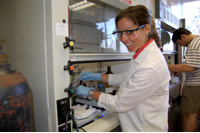
University:
Major:
Mentor(s):
Faculty Sponsor(s):
Faculty Sponsor's Department:
Project Title:
Project Description:
In recent years, considerable progress has been seen in the development of NMR techniques, directed towards enhancing both sensitivity and contrast in signal from soft matters and assemblies, such as proteins and lipid vesicles. The NMR signal of a variety of solvent and solute nuclei can be amplified by transferring polarization from electrons of nitroxide radicals to sample nuclei, known as ‘Overhauser Dynamic Nuclear Polarization (DNP)’. The permeability of lipid membranes to solvent, solute and ions impact many biological processes, including drug delivery and transmembane protein signal transduction. Particularly measuring the solute permeability of small molecules is not currently possible by using sensitive probe tagging techniques or isotope labeling NMR, because these techniques cannot provide site-specific information. In this study, we aim to establish a novel method to understand the solute permeability through a lipid membrane, specifically small molecules, by exploiting 13C –DNP NMR associated with an INEPT (insensitive nuclei enhanced by polarization) NMR pulse sequence. CAT-1 radical is known to be membrane impermeable and is used to polarize 13C spins of the permeable amino acid glycine outside the vesicle. In order to extract the permeability rate of glycine through the lipid bilayer, the decay of the 13C -DNP-INEPT signal as a function of time can be measured. The 13C -DNP-INEPT technique is well-suited for the fundamental studies of molecular transport effect in biological systems. It is expected to achieve higher sensitivity by making use of hyperpolarized 13C spins and faster DNP build-up rate, as well as to obtain a site specific contrast for small molecules. The success of this technique will have a variety of applications in both biological and materials systems.
